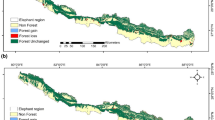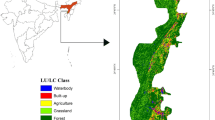Abstract
India is home of the largest remaining population of the Asian elephant (Elephas maximus L.) in the South and Southeast Asia. The forest loss and fragmentation is the main threat to the long-term survival of Asian elephants. In the present study, we assessed forest loss and fragmentation in the major elephant ranging provinces in India, viz., north-eastern, north-western, central, and southern since the 1930s. We quantified forest cover changes by generating and analyzing forest cover maps of 1930, 1975, and 2013, whereas fragmentation of contiguous forest areas was quantified by applying landscape metrics on the temporal forest cover maps. A total of 21.49% of the original forest cover was lost from 1930 to 1975, while another 3.19% forest cover was lost from 1975 to 2013 in the elephant ranges in India. The maximum forest loss occurred in the southern range (13,084 km2) followed by north-eastern (10,188 km2), central (5614 km2), and north-western (4030 km2) elephant ranges in the past eight decades. The forests in the central range were the most fragmented followed by southern, north-eastern, and north-western elephant ranges. The forest fragmentation in the southern range occurred at the fastest rate than central, north-eastern, and north-western ranges. The core forest areas shrunk by 39.6% from 1930 to 2013. The causative factors of forest change and situation of elephant-human conflict have been discussed. Study outcomes would be helpful in planning effective conservation strategies for Asian elephants in India.






Similar content being viewed by others
References
Baskaran, N., Varma, S., Sar, C. K., & Sukumar, R. (2011). Current status of Asian elephants in India. Gajah, 35, 47–54.
Baskaran, N., Kanakasabai, R., & Desai, A. A. (2018a). Ranging and spacing behavior of Asian elephant (Elephas maximus L.) in the tropical forests of southern India. In Indian hotspots (pp. 295–315). Singapore: Springer.
Baskaran, N., Kanakasabai, R., & Desai, A. A. (2018b). Influence of ranging and hierarchy on the habitat use pattern by Asian elephant (Elephas maximus L.) in the tropical forests of southern India. In Indian hotspots (pp. 345–358). Singapore: Springer.
Bist, S. S. (2002). Elephant conservation in India—an overview. Gajah, 25, 27–37.
Broadbent, N. E., Asner, G. P., & Keller, M. (2008). Forest fragmentation and edge effects from deforestation and selective logging in the Brazilian Amazon. Biological Conservation, 132, 145–157.
Chakraborty, K. (2009). Vegetation change detection in Barak Basin. Current Science, 96, 1236–1242.
Chartier, L., Zimmermann, A., & Ladle, R. J. (2011). Habitat loss and human-elephant conflict in Assam, India: does a critical threshold exist? Oryx, 45(4), 528–533.
Choudhury, A. (2004). Human – elephant conflicts in northeast India. Human Dimensions of Wildlife, 9, 61–270.
Choudhury, A., Choudhury, D.K.L., Desai, A, Duckworth, J.W., Easa, P.S., JohnSingh, A.J.T., Fernando, P., Hedges, S., Gunawardena, M., Kurt, F., Karanth, U., Lister, A., Menon, V., Riddle, H., Rübel, A. & Wikramanayake, E. (2008). “Elephas maximus”. IUCN Red List of Threatened Species. Version 2012.2. International Union for Conservation of Nature.
Dublin, H. T., & Hoare, R. E. (2004). Searching for solutions: the evolution of an integrated approach to understanding and mitigating human–elephant conflict in Africa. Human Dimensions of Wildlife, 9, 271–278.
Elephant Task Force Report of MoEF (2013). http://www.wiienvis.nic.in/Database/ElephantReserves_8226.aspx. Accessed on 10 July 2016.
Fernando, P., & Leimgruber, P. (2011). Asian elephants and seasonally dry forests. In W. J. McShea, S. J. Davies, & N. Bhumpakphan (Eds.), Ecology and conservation of seasonally dry forests in Asia (pp. 151–163). Smithsonian Scholarly Press.
Gubbi, S., Swaminath, M. H., Poornesha, H. C., Bhat, R., & Raghunath, R. (2014). An elephantine challenge: human – elephant conflict distribution in the largest Asian elephant population, southern India. Biodiversity and Conservation, 23(3), 633–647.
Hoare, R. E. (2000). African elephants and humans in conflict: the outlook for co-existence. Oryx, 34, 34–38.
Jathanna, D., Karanth, K. U., Kumar, N. S., Goswami, V. R., Vasudev, D., & Karanth, K. K. (2015). Reliable monitoring of elephant populations in the forests of India: analytical and practical considerations. Biological Conservation, 187, 212–220.
Johnsingh, A. J. T., Prasad, S. N., & Goyal, S. P. (1990). Conservation status of the Chila - Motichur corridor for elephant movement in Rajaji-Corbet National Parks area, India. Biodiversity and Conservation, 51, 125–138.
Kaim, D., Kozak, J., Ostafin, K., Dobosz, M., Ostapowicz, K., Kolecka, N., & Gimmi, U. (2014). Uncertainty in historical land-use reconstructions with topographic maps. Quaestiones Geographicae, 33(3), 55–63.
Kaim, D., Kozak, J., Kolecka, N., Ziółkowska, E., Ostafin, K., Ostapowicz, K., Gimmi, U., Munteanu, C., & Radeloff, V. C. (2016). Broad scale forest cover reconstruction from historical topographic maps. Applied Geography, 67, 39–48.
Kanagaraj, R., Araujo, M. B., Barman, R., Davidar, P., De, R., Digal, D. K., Gopi, G. V., Johnsingh, A. J. T., Kakati, K., Kramer-Schadt, S., & Lamichhane, B. R. (2019). Predicting range shifts of Asian elephants under global change. Diversity and Distributions, 25, 822–838. https://doi.org/10.1111/ddi.12898.
Kushwaha, S. P. S., Nandy, S., Shah, M. A., Agarwal, R., & Mukhopadhyay, S. (2018). Forest cover monitoring and prediction in a lesser Himalayan elephant landscape. Current Science, 115(3), 510–516.
Lahiri-Choudhury, D. K. (1980). An interim report on the status and distribution of elephants in north-east India. In J.C. Daniel (Ed.), The status of the Asian elephant in the Indian sub-continent (pp. 43–58). IUCN/SSC report, BNHS, Bombay, India.
Leimgruber, P., Gagnon, J. B., Wemmer, C., Kelly, D. S., Songer, M. A., & Selig, E. R. (2003). Fragmentation of Asia’s remaining wildlands: implications for Asian elephant conservation. Animal Conservation, 6, 347–359.
Liu, P., Wen, H., Harich, F. K., He, C., Wang, L., Guo, X., Zhao, J., Luo, A., Yang, H., Sun, X., & Yu, Y. (2017). Conflict between conservation and development: cash forest encroachment in Asian elephant distributions. Scientific Reports, 7(1), 6404.
Menon, S., & Bawa, K. S. (1998). Deforestation in the tropics: reconciling disparities in estimates for India. Ambio, 27, 576–577.
Menon, V., Tiwari, S. K., Easa, P. S., & Sukumar, R. (2005). Right of passage: elephant corridors of India. Conservation Reference Series 3 (p. 287). New Delhi: Wildlife Trust of India.
Nair, P.V., Sukumar, R. & Gadgil, M. (1980). The elephant in south India. In: The Asian elephant in the Indian subcontinent. In Daniel JC (ed.), IUCN/SSC Asian Elephant Specialist Group, c/o Bombay Natural History Society, Bombay.
Nandy, S., Kushwaha, S. P. S., & Mukhopadhyay, S. (2007). Monitoring the Chilla - Motichur wildlife corridor using geospatial tools. Journal for Nature Conservation, 15(4), 237–244.
Palei, N. C., Rath, B. P., & Kar, C. S. (2013). An assessment of human-Asian elephants (Elephas maximus) conflict in Mayurbhanj Elephant Reserve, Odisha. World Journal of Zoology, 8(3), 292–298.
Puyravaud, J. P., Cushman, S. A., Davidar, P., & Madappa, D. (2017). Predicting landscape connectivity for the Asian elephant in its largest remaining subpopulation. Animal Conservation, 20(3), 225–234.
Reddy, C. S., Rao, P. R. M., Pattanaik, C., & Joshi, P. K. (2009). Assessment of large-scale deforestation in Nawarangpur district, Orissa, India: a remote sensing based study. Environmental Monitoring and Assessment, 154, 325–335.
Reddy, C. S., Sreelekshmi, S., Jha, C. S., & Dadhwal, V. K. (2013). National assessment of forest fragmentation in India: landscape indices as measures of the effects of fragmentation and forest cover change. Ecological Engineering, 60, 453–464.
Reddy, C. S., Jha, C. S., Diwakar, P. G., & Dadhwal, V. K. (2015). Nationwide classification of forest types of India using remote sensing and GIS. Environmental Monitoring and Assessment, 187(12), 1–30.
Reddy, C. S., Jha, C. S., Dadhwal, V. K., Harikrishna, P., Pasha, S. V., Satish, K. V., Dutta, K., Saranya, K. R. L., Rakesh, F., Rajashekar, G., & Diwakar, P. G. (2016). Quantification and monitoring of deforestation in India over eight decades (1930-2013). Biodiversity and Conservation, 25, 93–116.
Sampson, C., Leimgruber, P., Tonkyn, D., Pastorini, J., Janaka, H. K., Sotherden, E., & Fernando, P. (2018). Effects of illegal grazing and invasive Lantana camara on Asian elephant habitat use. Biological Conservation, 220, 50–59.
Santiapillai, C., & Jackson, P. (1990). The Asian elephant: an action plan for its conservation. Gland, Switzerland: IUCN.
Santiapillai, C., & Ramono, W. S. (1990). Sumatran elephant database. A preliminary report (draft). IUCN/SSC Asian Elephant Specialist Group Newsletter., 5, 3–35.
Shahi, S.P. (1980). The elephant in central India. In: Daniel JC (ed.), The Asian elephant in the Indian subcontinent. IUCN/SSC Asian Elephant Specialist Group, c/o Bombay Natural History Society, Bombay.
Shahi, S.P. & Chowdhury, S. (1986). The status and distribution of elephants in Central India. Report of the IUCN/SSC Asian Elephant Specialist Group.
Singh, V. B. (1978). The elephant in U.P. (India): a resurvey of its status after 10 years. Journal of the Bombay Natural History Society, 75, 71–82.
Singh, K. N. (1995). Asiatic elephants in U.P. (India): status and strategy for conservation. In J. C. Daniel & H. Datye (Eds.), A week with elephants (pp. 32–48). New Delhi: Bombay Natural History Society, Bombay, and Oxford University Press.
Srivastava, S., Singh, T. P., Singh, H., Kushwaha, S. P. S., & Roy, P. S. (2002). Assessment of large-scale deforestation in Sonitpur district of Assam. Current Science, 82, 1479–1484.
Sukumar, R. (1989). The Asian elephant: ecology and management. Cambridge: Cambridge University Press.
Sukumar, R. (1993). The Asian elephant: ecology and management. 2nd edition: Cambridge University Press ISBN 0-521-43758-X.
Sukumar, R. (2006). A brief review of the status, distribution and biology of wild Asian elephants Elephas maximus. International Zoo Yearbook, 40, 1–8.
Sukumar, R., & Santipillai, C. (1996). Elephas maximus: status and distribution. In J. Shoshani & P. Tassy (Eds.), The Proboscidea: evolution and paleoecology of elephants and their relatives (pp. 327–331). New York: Oxford University Press.
Williams, A. C., Johnsingh, A. J. T., & Krausman, P. R. (2001). Elephant-human conflicts in Rajaji National Park, northwestern India. Wildlife Society Bulletin, 29, 1097–1104.
Acknowledgments
Authors acknowledge forest cover data support from the National Information System for Climate and Environment Studies (NICES), National Remote Sensing Centre, Hyderabad. Authors thank the Director of Indian Institute of Remote Sensing and the Director of National Remote Sensing Centre for their encouragement and support.
Author information
Authors and Affiliations
Corresponding author
Additional information
Publisher’s note
Springer Nature remains neutral with regard to jurisdictional claims in published maps and institutional affiliations.
This article is part of the Topical Collection on Terrestrial and Ocean Dynamics: India Perspective
Rights and permissions
About this article
Cite this article
Padalia, H., Ghosh, S., Reddy, C.S. et al. Assessment of historical forest cover loss and fragmentation in Asian elephant ranges in India. Environ Monit Assess 191 (Suppl 3), 802 (2019). https://doi.org/10.1007/s10661-019-7696-5
Received:
Accepted:
Published:
DOI: https://doi.org/10.1007/s10661-019-7696-5




